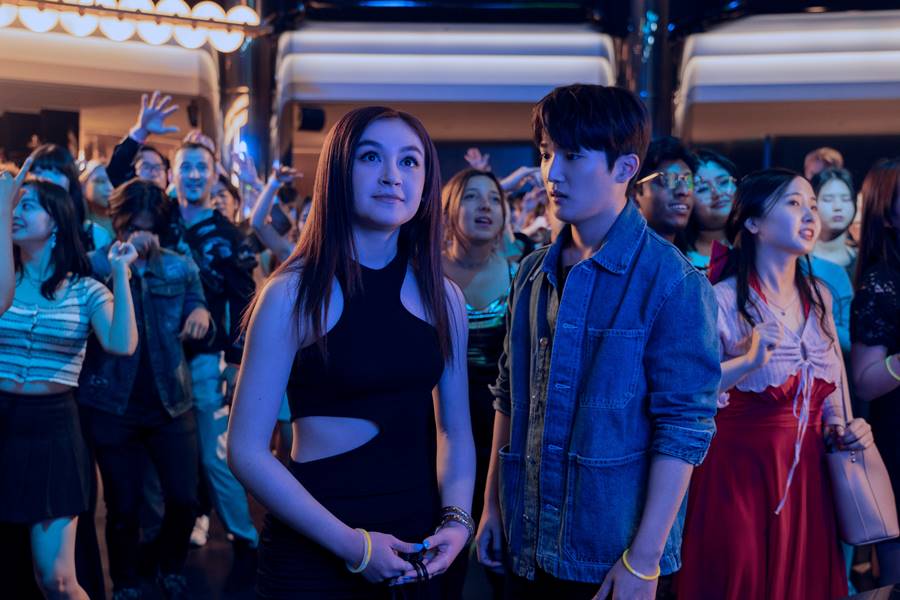
By Jae-Ha Kim
Substack
May 18, 2023
☆☆☆☆
Kitty (played by Anna Cathcart)
Dae (played by Choi Min-young)
↑Note: Korean names denote the surname followed by the given name.
In the “To All the Boys I’ve Loved” spinoff “XO, Kitty,” Anna Cathcart stars as Katherine “Kitty” Song Covey — a high school senior with a white dad and a deceased Korean American mother. Cathcart’s Kitty was a standout in the TATB trilogy, playing a matchmaker for her older sister (played by Lana Condor) and her hunky crush (Noah Centineo). The viewers had a vested interest in the lead couple remaining together and in Kitty — who was a baby when her mother died — who wanted to know more about the Korean side of her lineage.
In my 2021 review of “To All the Boys: Always and Forever,” I wrote:
While TATB author Jenny Han may have no desire to write a fourth book in this series, wouldn’t it be fun if Kitty got a spinoff? She could move to Seoul to become a K-pop trainee, learn Korean, and reunite with her crush Dae (Jeon Ho-Young). TATB doesn’t have to end with Lara Jean and Peter. With a little bit of tweaking, it can go on always and forever.
So I got a little bit of what I had hoped for — something completely Kitty-centric.
But while the spinoff tackles some important topics — adoption, gay and lesbian relationships, academic stress, Mean Girls, and identity — it is in way over its head in dealing with most of these topics in any meaningful way, because so much of the writing is superficial. As for the direction, it’s heavy handed and does disservice to the actors who we have seen do better work. Viewers know that Cathcart is a good actress who’s capable of doing so much more. Kudos to Choi Min-young — who replaced Jeon as Kitty’s crush Dae — whose acting experience helped overcome the clunky dialogue.
The basic thrust of this series goes like this: Kitty hasn’t seen Dae in four years, since they met cute as 13 years olds at Namsan Tower in Seoul. About to enter her senior year of high school, she finds one of her mother’s mementos from when she had studied abroad at the Korean Independent School of Seoul or … K.I.S.S. (Ew.) Coincidentally, this is the same school Dae attends. Without telling her father or stepmother, Kitty applies and gets in. She convinces them that this will be a good experience to learn more about her mother and her Korean heritage. And off she goes. By herself. Unaccompanied by her wealthy-enough parents who don’t think it might be a good idea to help their youngest daughter get settled into a foreign country where she doesn’t speak the language and knows no one except her penpal boyfriend, whom she hopes to surprise on their first day of school.
As goofy as this school is, one of the things they bring up is that while Kitty was a top student back in the United States, that doesn’t cut it in the cut-throat world of academics in South Korea — even in a school that caters to English speakers.
There are some spoilers ahead, but I assure you that if you watch this series, you will have guessed most of the plot before it actually happens.
Where is the Korean side of her family?
Like the TATB movies, “XO, Kitty” uses the deceased mother as a trope, while at the same time erasing her side of the family. Has every single member of her mother’s family emigrated from South Korea to another country? That is the only thing viewers can assume, since Kitty makes more effort to set up her new friends than to find any of her maternal relatives in Korea. This isn’t her fault. If anyone is to blame, it’s her father, who is presented as a sweet man who worries more about his daughters using birth control than passing along much about his late wife’s history. Is he clueless about her Korean family? Or does he just not care?
In the TATB films, Kitty and her sisters were depicted as wearing hanboks on New Year’s Day celebrations at their cousins’ house, while their full-Korean relatives just wore Western clothes. In some ways, this dressing up is simply a nod to the girls’ Korean culture without knowing anything about it. So when the international students at the school prepare to celebrate Chuseok together, Kitty has no idea what it is. Akin to Thanksgiving in the U.S., it’s one of the most important holidays in South Korea.
One of the things the series did touch on was her ambiguous looks. To paraphrase from the series: Is she white? Gyopo? What? No one faulted her for not speaking a lick of Korean prior to her arrival. But by the end of the first semester? She hadn’t progressed any in learning the language. It was disappointing that Kitty had this opportunity to study in Korea, but treated it as a high school Tinder more than anything else.
The adoption trope
One of the subplots in this series revolves around Kitty thinking that her mother had a baby while she was in Korea, who she then put up for adoption. Using the Korean hospital wristband her mother had saved to figure out where she needed to infiltrate, Kitty sneaks into the archives department, types in her mother’s name, and discovers that someone with her mom’s name gave birth to a baby, who would now be about 30 years old. 😬 Never mind that this literally never happens. Without showing any real signs of concern for her mother or the child, Kitty goes into nosy mode and is convinced that a teacher at K.I.S.S. — an adoptee — is her half brother.
This morning, one of my Korean adoptee friends messaged me about Korean adoptee actor Peter Thurnwald, who plays the K.I.S.S. teacher who had been adopted. Both Jennifer (my friend) — who has a son who was also adopted from South Korea — and Thurnwald had been adopted into white families. She said:
Something I wonder about, which is really none of my business, is how adoptees process their adoption when they are adopted into a Korean family. What I mean by that is their parents grew up in a Korean household. I wonder if they send their kids to adoptee camps and discuss being adopted with them. Granted, I’m sure you’ve heard the term white saviorism. I feel like some Korean families believe that rhetoric too. [My son] doesn’t have to necessarily “deal” with adoption the way I did, simply because he’s not questioned about his family all of the time.
In the series, Thurnwald’s character is quickly reunited with his birth mother. Instead of harboring any anger towards her, he is understanding and says he doesn’t want to disrupt her life. While this is a commendable reaction, it’s also one that rings hollow. Even if an adoptee was sympathetic to his birth mother’s needs at the time, wouldn’t it be fair for him to have some complex emotions that need to be worked through? None of that is addressed here. It’s all about the unhinged birth mother freaking out that the secret will ruin her life.
And one of the issues I have with “XO, Kitty” is how carelessly the creatives treat South Korea’s complicated history of sending babies away for adoption. They chose to use an adoptee as a plot device without adding any nuance. WTF?
I haven’t read any of the reviews that were published today, because I don’t want them to cloud my own assessment of this series. But I’ll bet you that most will describe this series as a fun and charming show, without any talking points about the adoption element in any relevant way.
At the moment, I would not say I am 100 percent actively searching for my mother. I think that is a completely different story that I would like to tell in the future. But as of now, I am very comfortable with who I am and what I stand for. If I was to go and find her, I would want it to improve my life, not take away from it.”

A film instead of a series would have been better
It’s to the young cast’s credit that they do a good enough job with what they’re given. But I couldn’t help thinking that this series — which is split into 10 half-hour episodes — would’ve fared better if it had been streamlined into a cohesive 90-minute movie without the superfluous fillers. The five hours of “XO, Kitty” felt like a never-ending series, because the characters refused to say what was on their minds.
These are teenagers. Are we to believe that they don’t text each other nonstop to vent and/or resolve their issues? Or confront each other about blatant misunderstandings that could be straightened out with literally one sentence?
“XO, Kitty” is akin to “Emily in Paris.” They’re both filmed on location in scenic countries (South Korea and France, respectively) and offer charming casts. But the content is just meh.
To be fair, after watching early screeners of this Netflix series prior to it releasing today, I chatted with some of my colleagues who had also watched it. All of them liked the show. None of them are Korean or Korean diaspora, though, and I wonder if that makes a difference.
The best part of this show was the music, which include tracks by BTS, Momoland, Seventeen, Wonho, Stray Kids, Blackpink and … Tears for Fears. “Everybody Wants to Rule the World” apparently was Kitty’s mom’s favorite song.
Dr. Areum Jeong succinctly assessed “XO, Kitty” with her tweet:
Sorry #XOKitty, but this first-gen #Kpop fan is far more interested in the mixtape playlist your mom's high school bf made for her than your relationship with Dae! 😂
Classic hits from 1993-4 💿📀🧵 pic.twitter.com/yRKQyefkLW
— Areum Jeong 정아름 (@DrAreumJeong) May 18, 2023
In an article I wrote about TATB a few years back, I said:
Korean-American authors like [TATB author] Jenny Han [who also wrote the “XO, Kitty” script] absolutely should not feel the burden of creating only Korean-American characters. But since she did, it would’ve been meaningful to see what Lara Jean’s trip back to Korea meant to her in the bigger picture, even if to acknowledge that it was really little more than a beautiful vacation. And that would’ve been OK, too.
And that’s ultimately what’s missing from “XO, Kitty” — a sense of who she is, informed by her mother’s Korean-ness. Because it’s obvious that the impetus for studying abroad wasn’t really about learning more about her mother. It was to reunite with Dae.

Trivia
Two of the cast members are real-life siblings: Sang-heon Lee (who plays rich hottie Min-ho) and Gia Kim (who portrays Kitty’s frenemy Yuri).
Articles about adoption and how it’s presented in Korean media
• How “Broker” and “Return to Seoul” Reveal the Hard Truths About Korean Adoption (Mashable)
• Adoption in K-dramas: The Good, the Bad, and the Work in Progress (Teen Vogue)
• “Vincenzo” and adoption myth entrenched in Korean society (Korea Times)
• Don’t Believe the K-dramas: Look to “Return to Seoul” for a More Realistic View on Korean Adoptees (Salon)
Airdates: Ten half-hour episodes dropped May 18, 2023 on Netflix.
Spoiler Alert: Kitty’s mother didn’t get pregnant as a teen. It was her high school best friend, who now runs K.I.S.S. Kitty and Dae break up in the final episode, and that was arguably the best scene in the series. They both realized that they were each other’s first loves that they’ll always remember. The finale also set up a second season with Kitty and Min-ho on the same flight flirting.
© 2023 JAE-HA KIM | All Rights Reserved






The white dad has always bothered me and you articulated why. Really bad series. My kids thought it was OK, but they didn’t want to see more than a couple episodes.
Thanks god you watched it! I was about to ask for your opinion. I watched it yesterday and even tho im not used to give my large opinion on series, this one was hard to ignore. Im not saying it’s bad… but it’s not really good neither 😅
Omw to read you!
It’s a boarding school so yes her family is not going to be there because they live in another country. They do explore more in the movie series concerning Korean culture. Lastly kdramas have similar tropes also within them too. So do movies or any tv series in general
Also this is not a lifestyle docu series into South Korea. It’s more of a coming of age tale about a young girl trying to find herself. Which does include her mom that she never really knew. But herself mainly. Hopefully if they get another season they can maybe dive deeper.
?? I think you’re confused. She’s not talking about her nuclear family in the U.S. Kitty’s in Korea for the series. The dead mom had Korean relatives. But it doesn’t occur to her dad or Kitty that it might be worthwhile for Kitty to learn more about her mom by trying to find them and meet them.
Other shows having bad tropes doesn’t make it right or good. It’s a weak boring series and if you like it, fine, but stop trying to rationalize why you like it by nitpicking on valid points in this review.
All the other reviews were by white people who know nothing about Korean culture. They missed all the points that you mentioned.
I wish I had read your review before I bingewatched it this morning. I kept hoping it would get better. I want my 5 hours back!
Nailed it! Felt like they were trying to bank off the success of kdramas and failed 😭 I’m disappointed since I loved Kitty in TATB
OMG Jae you were way too nice. I watched this with my daughter after school today and we both cringed. The actress who plays Yuri is horrible, Anna acts like she’s on some cheap sit com. This just proved to me that after watching superior Korean dramas, the U.S. can’t hold a candle. FWIW we’re not Korean or even Asian. My daughter is almost 13.
They could’ve just named it “Korean International School of Science” or “of Semantics” or “of Something”! I’m really annoyed by how “of Seoul” refuses to slide down my tongue well, hahaha. It’s lazy.
When the acting is this bad, all I could do was concentrate on superficial things like how unattractive the entire cast is (except for the actor who played Min ho). I know that’s not a nice thing to say, but a lot of people noticed this too. Kdramas are popular for a reason and XO Kitty was a poor attempt at copying that genre.
Just finished watching XO Kitty and ran to read Jae-ha’s post. I’d been saving it until I had my own thoughts on the show firmly in place. Jae-ha nails it though. It’s 3 hours too long, the actors improve a weak script, and the adoption trope is hella clunky in its execution. Read her whole write up please!